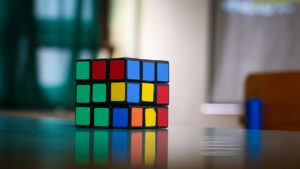No two students are alike, so no two students will learn in the same way – or at the same pace. This presents a challenge for educators when the students outnumber the teachers. Here, we’ll talk through two methods of instruction: the traditional method and the mastery-based method.
Let’s take a look at how Clare, a traditional math teacher, creates her lesson plans.

She has 5 lessons to teach this unit, and she’s planning for each lesson to take about 5 days for her students to master. At the end of each lesson, the students take a test and move on to the next lesson.

Now let’s look at one of her students, Hunter.

Math is one of Hunter’s favorite subjects, and he usually understands and masters topics quickly. His mastery map for these five lessons would look something like this:

If Hunter were free to move at his own pace, he would master the material sooner, leaving more time for him to move on to more advanced topics or explore in-depth a topic that interested him in this unit. This is called the mastery model of teaching.
However, since Hunter is in a traditional classroom, he is often left with extra time after he has mastered each lesson. Hunter is probably bored, and hopefully that’s the worst side effect of this system. High-performing students also start acting out during this time when their minds are not engaged.

Along with boredom, Hunter has missed opportunity because of the traditional method of teaching his teacher is using. While that’s unfortunate, he’s still getting everything the curriculum says he needs out of his education, so the method can’t be that bad, right?
Let’s take a look at the mastery map of another student, Michelle.

Michelle prefers reading and art to anything with numbers. Sometimes Michelle needs a few extra days to master a lesson, especially when she’s starting a new unit with new concepts.

Overall, she might need a couple more days to complete the unit compared to the rest of the class, but she’s not far from the time the teacher has budgeted for the unit.
Typically, each lesson builds on the next, which causes a problem in a traditional classroom. Because Michelle doesn’t get to completely master the first lesson, it’s almost impossible for her to understand the next lesson. By the middle of the unit, she’s wasting her time trying to learn the more complex lessons because she’s missing the foundation from lesson one. There are so many students who think they’re bad at a subject and even learn to dislike it because they didn’t have time to master the foundational skills.

The traditional method of instruction is sometimes referred to as the fixed-time, variable-learning method. Students are given a defined time frame in which to learn material, regardless of how much material they can actually master during that time frame.
On the other hand, the mastery-based method of instruction is also called the fixed-learning, variable-time method. Rather than having a set time limit, students have a set amount of material to master, and they continue working on it until they have mastered it. This model allows students to spend time on things they’re having difficulty with and prevents them from being bored with material they find easier. After all, no two students are the same.
If this model is so great, why don’t all schools use it? While this would be a preferred method for instructors and students alike, when one teacher has to teach 20+ students, it’s just not possible to personalize education for each of them. However, with the arrival of eLearning software, the repetitive drills and grading of each student’s work can be outsourced to a machine. The teacher is then free to guide students along their own path – at their own pace.



